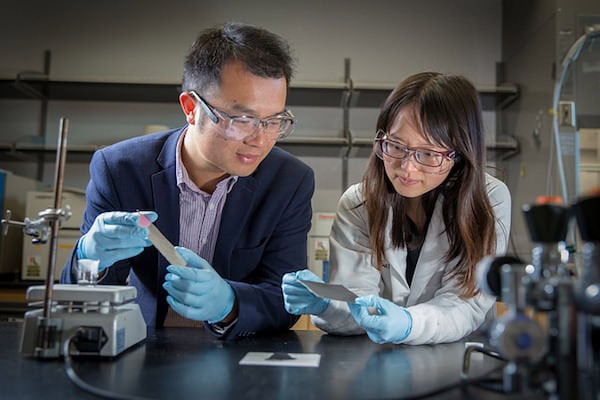
[Image above] Professor Zheng Chen (left) and first author Yang Shi of UC San Diego developed a method to recycle and regenerate cathodes of spent lithium-ion batteries. Credit: UC San Diego; Flickr
Lithium-ion batteries have been a hot research topic for years. Ceramic Tech Today has reported on all sorts of research, from developing faster-charging batteries to making them greener.
And although lithium-ion battery research is important for making our electronics faster charging and greener, it’s even more critical as the market for electric vehicles (EVs) continues to develop.
According to the EPA, the transportation sector is responsible for 27% of U.S. greenhouse gas emissions. That includes cars, trucks, aircraft, and railroads. Increased EV adoption will eventually make our environment a lot greener.
But what about those batteries that power EVs?
An article in Scientific American claims that the power used to charge electric vehicle batteries could negate environmental advantages (i.e., low emissions) unless the power plants are operating under solar, wind, or nuclear power.
And the other caveat—what to do with all of those spent lithium batteries when they eventually bite the dust?
A team of engineers led by professor of nanoengineering at the University of California San Diego Zheng Chen is already working on that. The scientists have created a process that recycles cathode particles from spent lithium-ion batteries and can be used in new batteries. By taking used cathode particles from the spent batteries, they restored them through a heat-treating process in a hot alkaline solution of lithium salt. Even the solution can be recycled, according to a UC San Diego news release.
“Think about the millions of tons of lithium-ion battery waste in the future, especially with the rise of EVs, and the depletion of precious resources like lithium and cobalt—mining more of these resources will contaminate our water and soil,” Chen explains in the release. And all lithium-ion batteries—not just the larger ones used in EVs—pose a potential threat to the environment.
According to the researchers, less than 5% of lithium batteries are recycled. And their process could likely lower initial battery costs because lithium, cobalt, and nickel have become increasingly expensive to mine and process. Their recycling method works with cathode material lithium cobalt oxide—used in electronics—and lithium nickel-manganese-cobalt (NMC), a cathode material used in EVs.

Used cathode particles from spent lithium-ion batteries are recycled and regenerated to work as good as new. Credit: David Baillot, UC San Diego Jacobs School of Engineering
Chen says their process is the same one used to make battery cathodes. Tests of the regenerated cathodes showed that charging time, energy storage capacity, and battery life was the same as a brand new battery. And lithium concentration and atomic structure were returned to their original states. “We can simply restore the degraded material by putting it through the same processing steps,” he notes.
Chen’s team has already applied for a patent and is still working to improve the process to recycle other battery materials. The plan is to scale it for industry, and the team is currently developing a process to recycle battery anodes.
The research could be a leap of progress for reducing not only rechargeable battery costs, but also reducing the depletion of resources and environmental impact.
The paper, published in Green Chemistry, is “Effective regeneration of LiCoO2 from spent lithium-ion batteries: a direct approach towards high-performance active particles” (DOI: 10.1039/C7GC02831H).
Did you find this article interesting? Subscribe to the Ceramic Tech Today newsletter to continue to read more articles about the latest news in the ceramic and glass industry! Visit this link to get started.
Author
Faye Oney
CTT Categories
- Basic Science
- Electronics
- Energy
- Environment
- Manufacturing


